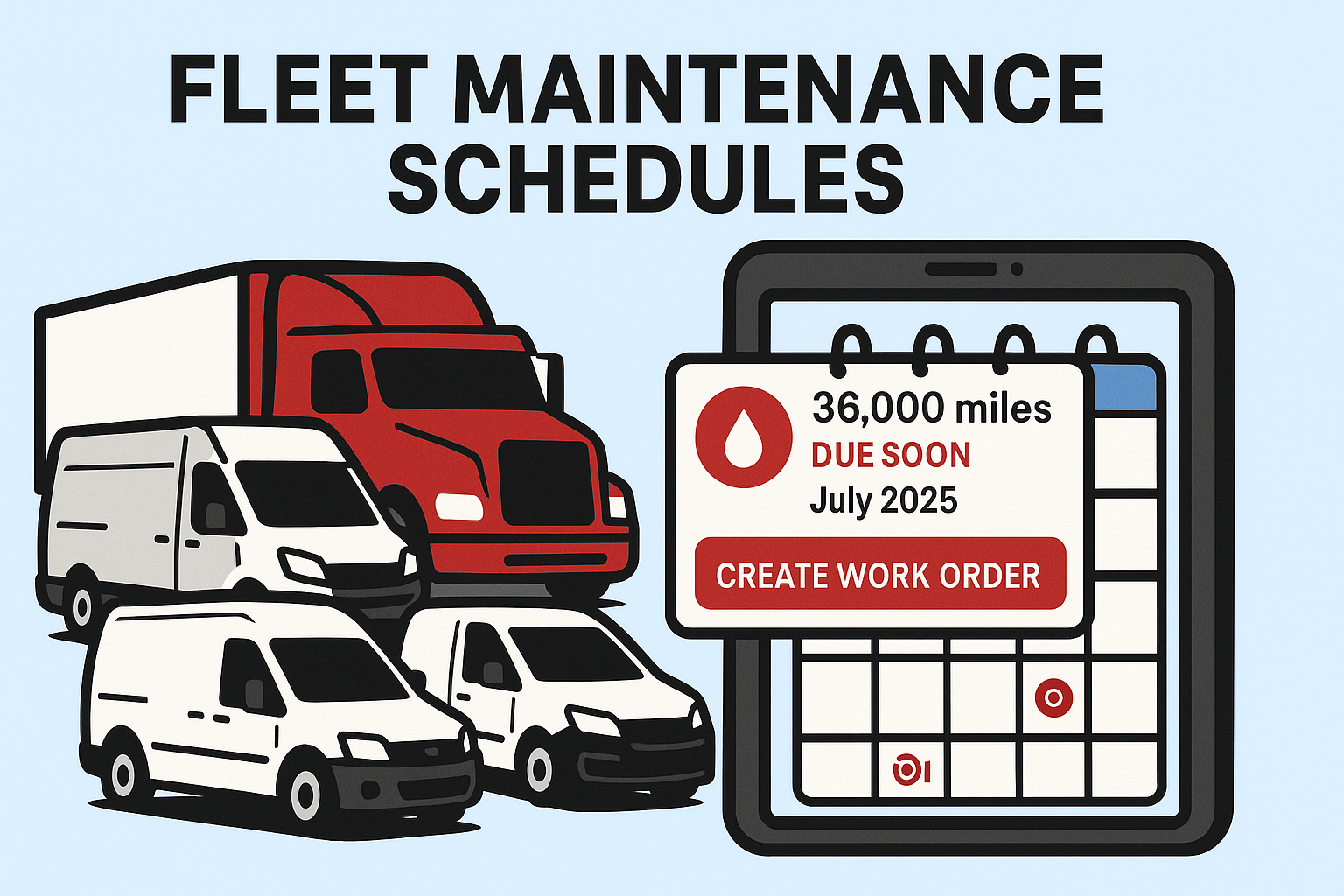 Miya Bholat
Miya Bholat
Aug 18, 2025
How to Transform Your Fleet Preventative Maintenance Scheduling Process

If you've ever managed a fleet of vehicles, you know the sinking feeling when a truck breaks down at the worst possible moment. Maybe it's a delivery vehicle that fails during peak season, or a service van that leaves your technician stranded at a customer site. These breakdowns don't just cost money—they damage your reputation and stress your entire operation.
How do you solve this dilemma and stay prepared? The answer lies within the adoption of fleet software. Modern fleet maintenance software has revolutionized how businesses approach vehicle maintenance, transforming it from a reactive scramble into a proactive, well-orchestrated strategy. Let's dive into how automated maintenance scheduling can keep your fleet running smoothly and your business moving forward.
The Problem with Traditional Preventative Maintenance Scheduling
Most fleet managers still juggle maintenance schedules using spreadsheets, sticky notes, or basic calendar systems. This approach creates a cascade of problems that compound over time. Missed services lead to expensive breakdowns, while over-maintenance wastes precious time and money.
Lost paperwork and incomplete maintenance records make it impossible to track vehicle history effectively. Perhaps most frustrating of all, inventory shortages leave vehicles sitting in the shop waiting for parts that should have been ordered weeks ago. Add compliance issues with regulatory requirements, and you've got a recipe for operational chaos.
This approach creates several challenges:
- Missed services that lead to expensive breakdowns
- Over-maintenance that wastes time and money
- Lost paperwork and incomplete maintenance records
- Inventory shortages when parts aren't ordered in advance
- Compliance issues with regulatory requirements
When you're managing 5, 50, or 500 vehicles, these manual processes quickly become overwhelming and error-prone.
How Modern Fleet Maintenance Software Enhances Operations
Today's fleet maintenance platforms integrate directly with Original Equipment Manufacturer (OEM) maintenance schedules, creating a seamless, automated approach to vehicle care. Here's how it works:
Automatic Schedule Creation Using OEM Guidelines
Today's fleet maintenance platforms integrate data from Original Equipment Manufacturer (OEM) maintenance schedules, creating a seamless, automated approach to vehicle care. Instead of guessing when services are due or relying on generic maintenance intervals, these systems pull exact specifications from the manufacturers themselves.
Instead of guessing when your vehicles need service, the software pulls maintenance requirements directly from manufacturer specifications. It considers factors like:
- Vehicle make, model, and year
- Engine type and specifications
- Mileage intervals
- Time-based service requirements
- Operating conditions and usage patterns
This means your 2023 Ford Transit gets serviced according to Ford's exact recommendations, while your Chevy Silverados follow Chevrolet's guidelines—all automatically tracked and scheduled.
Smart Reminders That Actually Work
The system monitors each vehicle's mileage and usage in real-time, sending alerts well before service is due. You might receive notifications like:
- "Vehicle #47 needs oil change in 500 miles"
- "Annual inspection due for Fleet Unit 12 in 2 weeks"
- "Brake service recommended for Van #23 based on usage patterns"
These aren't just calendar reminders—they're intelligent alerts based on actual vehicle data.
Comprehensive Work Order Management
When service time arrives, the software generates detailed work orders that include:
- Specific tasks based on OEM recommendations
- Required parts and quantities
- Estimated labor time
- Technician assignments
- Cost tracking and budget monitoring
Everything is documented digitally, eliminating lost paperwork and ensuring consistency across all maintenance activities.
Inventory Integration and Management
The system automatically tracks parts usage and maintains inventory levels. When a work order is completed, used parts are deducted from inventory, and the system can automatically reorder items when stock runs low. This prevents the frustrating scenario where your fleet is down because you're missing a $20 filter.
Complete Maintenance History Logging
Every service, repair, and inspection gets logged with details like:
- Date and mileage of service
- Work performed and parts used
- Technician notes and photos
- Costs and warranty information
- Next scheduled maintenance
This creates a comprehensive vehicle history that helps with warranty claims, resale value, and identifying recurring issues.
Industry-Specific Fleet Maintenance Software Benefits
Different industries see unique advantages from automated preventative fleet maintenance scheduling:
Transportation and Logistics
For trucking companies and logistics providers, vehicle uptime directly impacts revenue. Automated maintenance scheduling helps by:
- Reducing roadside breakdowns that disrupt delivery schedules
- Maintaining DOT compliance with automated inspection tracking
- Optimizing route planning around scheduled maintenance windows
- Improving fuel efficiency through properly maintained engines
Many customers see savings of at least 25% on maintenance. If you’d like to determine your potential fleet management software ROI, you can calculate it here.
Construction Industry
Construction fleets face harsh operating conditions that accelerate wear and tear. Fleet management software helps by:
- Adapting maintenance schedules for severe-duty operations
- Tracking equipment across multiple job sites
- Ensuring safety compliance for heavy machinery
- Managing specialized equipment with unique maintenance requirements
Construction companies often see immediate ROI through reduced equipment failures and improved project timelines.
Field Service Operations
HVAC, plumbing, electrical, and other service businesses depend on reliable vehicles to reach customers. Benefits include:
- Minimizing service call cancellations due to vehicle problems
- Maintaining professional image with well-maintained service vehicles
- Reducing emergency repair costs through preventive maintenance
- Improving technician productivity by eliminating unexpected breakdowns
Delivery and E-commerce
With the boom in online shopping, delivery fleets are working harder than ever. Automated maintenance helps by:
- Supporting high-mileage operations with appropriate service intervals
- Managing mixed fleets of vans, trucks, and specialized vehicles
- Coordinating maintenance with seasonal demand fluctuations
- Tracking vehicle performance across different delivery routes
Public Utilities and Emergency Services
Government fleets and emergency services have unique accountability requirements. The software provides:
- Detailed compliance reporting for regulatory agencies
- Budget tracking and forecasting for public accountability
- Emergency response readiness through proactive maintenance
- Asset lifecycle management for capital planning
Moving Forward: From Reactive to Preventative Maintenance
The shift from reactive maintenance to preventative fleet maintenance is about changing how you think about your vehicles. Instead of waiting for problems to occur, you're preventing them. Instead of fighting fires, you're building systems that keep your fleet running smoothly.
Modern fleet management software makes this transformation accessible to businesses of all sizes. Whether you're managing 5 vehicles or 500, automated maintenance scheduling can help you reduce costs, improve reliability, and focus on what you do best. In today's competitive landscape, the companies that operate most efficiently are the ones that survive and thrive.
Want to see how automated fleet maintenance scheduling could work for your specific operation? Contact our team for a personalized demo that shows real ROI that controls fleet costs and streamlines operations.